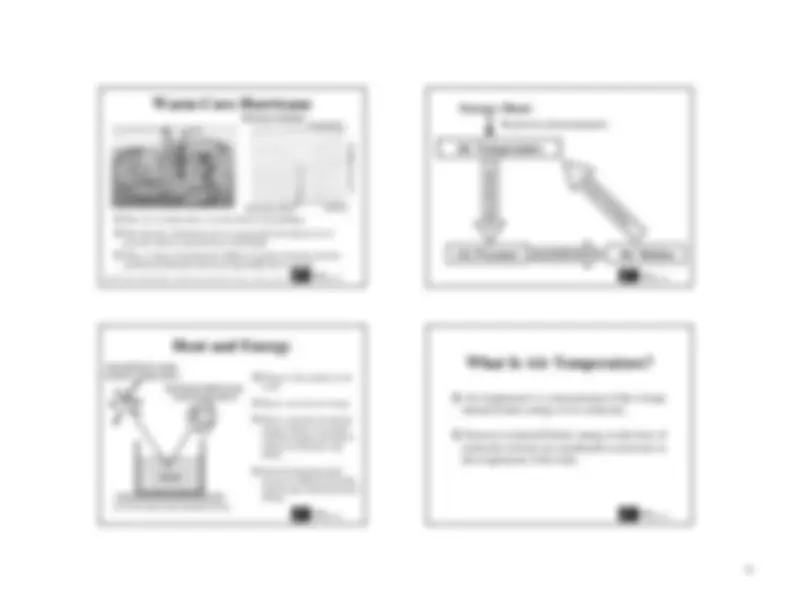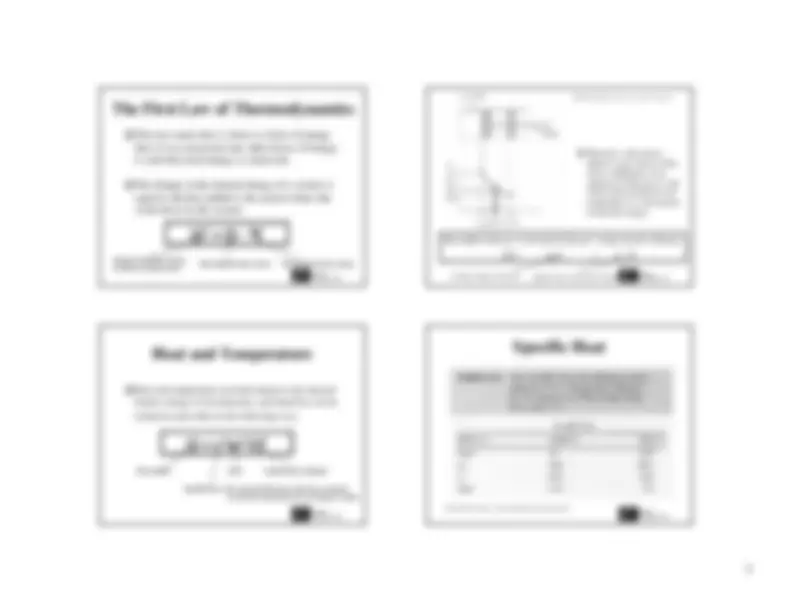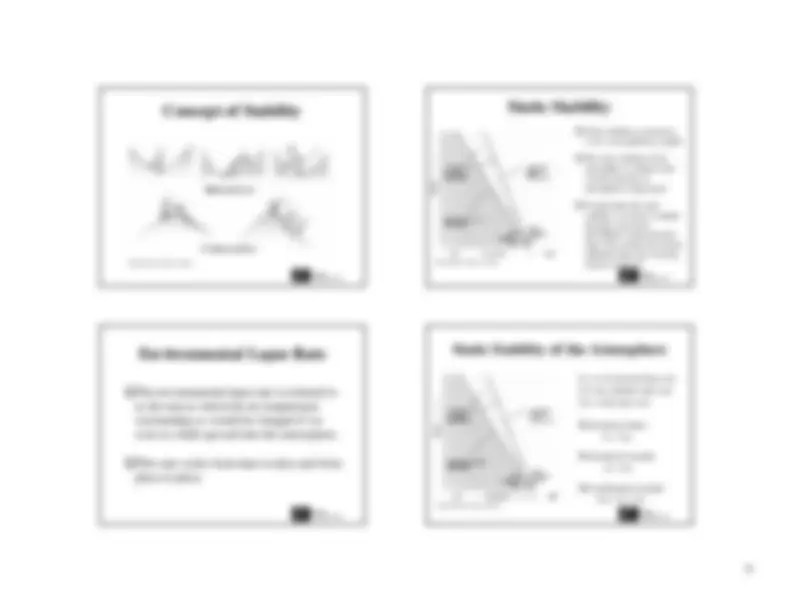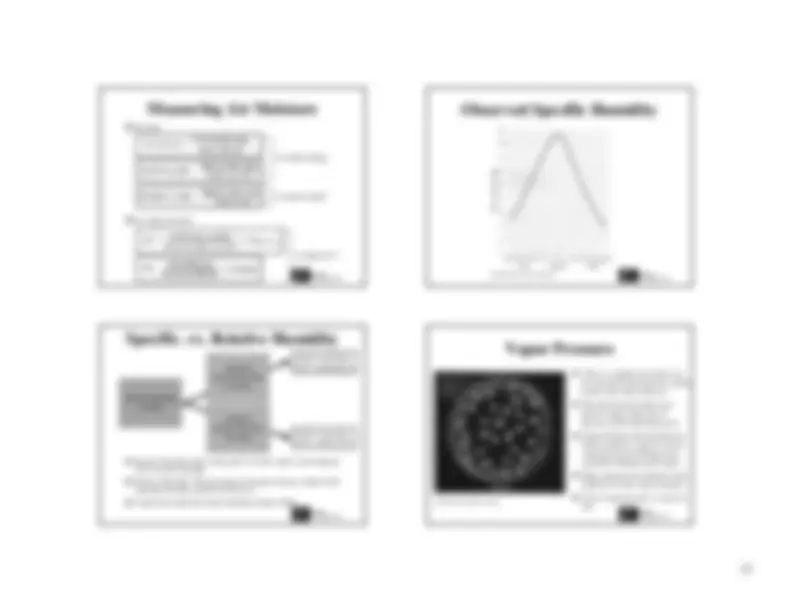











Study with the several resources on Docsity

Earn points by helping other students or get them with a premium plan


Prepare for your exams
Study with the several resources on Docsity

Earn points to download
Earn points by helping other students or get them with a premium plan
Community
Ask the community for help and clear up your study doubts
Discover the best universities in your country according to Docsity users
Free resources
Download our free guides on studying techniques, anxiety management strategies, and thesis advice from Docsity tutors
The Ideal Gas Law. ❑ An equation of state describes the relationship among pressure, temperature, and density of any material. ❑ All gases are found to ...
Typology: Slides
1 / 16

This page cannot be seen from the preview
Don't miss anything!










ESS55Prof. Jin-Yi Yu
ESS55Prof. Jin-Yi Yu
An
equation of state
describes the relationship among pressure,
temperature, and density of
any material
All gases are found to follow approximately the same equationof state, which is referred to as the
“ideal gas law (equation)”
Atmospheric gases, whether considered individually or as amixture, obey the following ideal gas equation:
(degree Kelvin)
(its value depends on the gas considered)
ESS55Prof. Jin-Yi Yu
The ideal gas law can be applied to the combination ofatmospheric gases or to individual gases.
The value of gas constant for the particular gas underconsideration depends on its molecular weight:
gas
gas
where R* = universal gas constant = 8314.3 J deg
kg
The gas constant for dry atmospheric air is:
air
air
= 8314.3/28.97 = 287 J deg
kg
air
N
O
The gas constant for water vapor is:R
vapor
vapor
= 461 J deg
kg
ESS55Prof. Jin-Yi Yu
Question:
Calculate the density of water vapor which exerts a
pressure of 9 mb at 20°C. Answer: Use the ideal gas law:
v
ρ
v
and
v
= 9 mb = 900 Pa (a SI unit)
v
v
= 461 J deg
kg
So we know the density of water vapor is:
ρ
v
v
T) = 900 / (461*293) = 6.67 x 10
kg m
(from
Atmospheric Sciences: An introductory Survey
)
ESS55Prof. Jin-Yi Yu
Moist air has a lower apparent molecular weight that dry air.
Î
The gas constant for 1 kg of moist air is larger than that for 1 kg ofdry air.
Î
But the exact value of the gas constant of moist air would depend on the amount of water vapor contained in the air.
Î
It is inconvenient to calculate the gas constant for moist air.
It is more convenient to retain the gas constant of dry air and use afictitious temperature in the ideal gas equation.
Î
This fictitious temperature is called “virtual temperature”.
Î
This is the temperature that dry air must have in order to has the samedensity as the moist air at the same pressure.
Î
Since moist air is less dense that dry air, the virtual temperature isalways greater than the actual temperature.
ESS55Prof. Jin-Yi Yu
Where
T: actual temperaturep: actual (total) pressure = p
d
p
d
: partial pressure exerted by dry air e: partial pressure exerted by water vapor
ε
d
v
ESS55Prof. Jin-Yi Yu
vertical pressure force = gravitational force
ρ
x (dz) x (dA) x g
dP = -
ρ
gdz
dP/dz = -
ρ
g
(from
Climate System Modeling
)
The hydrostatic balance !!
ESS55Prof. Jin-Yi Yu
ESS55Prof. Jin-Yi Yu
The core of a hurricane is warmer than its surroundings.
The intensity of the hurricane (as measured by the depression ofpressure surface) must decrease with height.
Thus, a warm core hurricane exhibits its greatest intensity near theground and diminish with increasing height above ground.
(from
Understanding Weather & Climate and Atmospheric Sciences: An Intro. Survey)
surface
tropopause
hurricane center
ESS55Prof. Jin-Yi Yu
hydrostatic balance
geostrophic balance
thermal wind balance
The first law of thermodynamics
ESS55Prof. Jin-Yi Yu
Energy is the capacity to dowork.
Heat is one form of energy.
Heat is one form of internalenergy which is associatedwith the random, disorderedmotion of molecules andatoms.
Internal kinetic/potentialenergy are different from themacroscopic kinetic/potentialenergy.
water
no macroscopic kinetic/potential energy
internal kinetic energy (related to temperature)
internal potential energy
(related to the phase)
ESS55Prof. Jin-Yi Yu
Air temperature is a measurement of the average internal kinetic energy of air molecules.
Increase in internal kinetic energy in the form of molecular motions are manifested as increases inthe temperature of the body.
ESS55Prof. Jin-Yi Yu
This law states that (1) heat is a form of energythat (2) its conversion into other forms of energyis such that total energy is conserved.
The change in the internal energy of a system isequal to the heat added to the system minus thework down by the system:
change in internal energy(related to temperature)
Heat added to the system
Work done by the system
ESS55Prof. Jin-Yi Yu
Therefore, when heat isadded to a gas, there will besome combination of anexpansion of the gas (i.e. thework) and an increase in itstemperature (i.e. the increasein internal energy):
Heat added to the gas = work done by the gas + temp. increase of the gas
p
∆α
v
volume change of the gas
specific heat at constant volume
(from
Atmospheric Sciences: An Intro. Survey)
ESS55Prof. Jin-Yi Yu
Heat and temperature are both related to the internalkinetic energy of air molecules, and therefore can berelated to each other in the following way:
Heat added
Specific heat = the amount of heat per unit mass required
Mass to raise the temperature by one degree Celsius
Temperature changed
ESS55Prof. Jin-Yi Yu
(from
Meteorology: Understanding the Atmosphere
)
ESS55Prof. Jin-Yi Yu
Radiation is heat transfer by the emission ofelectromagnetic waves which carry energy awayfrom the emitting object.
The solar energy moves through empty spacefrom the Sun to the Earth and is the originalenergy source for Earth’s weather and climate.
ESS55Prof. Jin-Yi Yu
Latent heat is the heat released or absorbed per unit mass whenwater changes phase.
Latent heating is an efficient way of transferring energyglobally and is an important energy source for Earth’s weatherand climate.
(from
Meteorology:
Understanding theAtmosphere
)
80 cal/gm
600 cal/gm
680 cal/gm
ESS55Prof. Jin-Yi Yu
The latent heat of evaporation is a function ofwater temperature, ranging from 540 cal per gramof water at 100°C to 600 cal per gram at 0°C.
It takes more energy to evaporate cold water thanevaporate the same amount of warmer water.
ESS55Prof. Jin-Yi Yu
ESS55Prof. Jin-Yi Yu
(from
The Blue Planet
)
ESS55Prof. Jin-Yi Yu
Air molecules in the parcel (or the balloon) have to use their kinetic energy to expand the parcel/balloon.
Therefore, the molecules lost energy and slow down theirmotions
The temperature of the air parcel (or balloon) decreases with elevation. The lost energy is used to increase the potentialenergy of air molecular.
Similarly when the air parcel descends, the potential energy ofair molecular is converted back to kinetic energy. Î
Air temperature rises.
ESS55Prof. Jin-Yi Yu
(from
Meteorology: Understanding the Atmosphere
)
ESS55Prof. Jin-Yi Yu
Meteorology: Understanding the Atmosphere
)
ESS55Prof. Jin-Yi Yu
(from
Meteorology Today)
ESS55Prof. Jin-Yi Yu
(from
Meteorology Today)
ESS55Prof. Jin-Yi Yu
(from
Meteorology Today)
ESS55Prof. Jin-Yi Yu
End of Day
Night
(from
Is the Temperature Rising?)
ESS55Prof. Jin-Yi Yu
Neutral Atmosphere (Coning)Stable Atmosphere (Fanning)Unstable Atmosphere (Looping)Stable Aloft; Unstable Below (Fumigation)Unstable Aloft; Stable Below (Lofting)
(from
Is the Temperature Rising?)
ESS55Prof. Jin-Yi Yu
The potential temperature of an air parcel is defined as the thetemperature the parcel would have if it were movedadiabatically from its existing pressure and temperature to astandard pressure P
0
(generally taken as 1000mb).
θ
= potential temperature
T = original temperatureP = original pressureP
0
= standard pressure = 1000 mb
R = gas constant = R
d
= 287 J deg
kg
p
= specific heat = 1004 J deg
kg
p
ESS55Prof. Jin-Yi Yu
In the atmosphere, air parcel often moves aroundadiabatically. Therefore, its potential temperatureremains constant throughout the whole process.
Potential temperature is a conservative quantity foradiabatic process in the atmosphere.
Potential temperature is an extremely useful parameterin atmospheric thermodynamics.
ESS55Prof. Jin-Yi Yu
The expression of potential temperature can be modified into:
**T = (constant ***
θ
0.
(from
Atmospheric Sciences: An Intro. Survey)
(from
The Physics of the Atmospheres)
ESS55Prof. Jin-Yi Yu
by mass
by vapor pressure
in unit of g/kgin unit of g/m
3
in unit of %
ESS55Prof. Jin-Yi Yu
(from
Meteorology Today)
ESS55Prof. Jin-Yi Yu
Specific Humidity: How many grams of water vapor in one kilogramof air (in unit of gm/kg).
Relative Humidity: The percentage of current moisture content to thesaturated moisture amount (in unit of %).
Clouds form when the relative humidity reaches 100%.
specific humidity
6 gm/kg
saturated
specific humidity
10 gm/kgsaturated
specific humidity
20 gm/kg
Relative humidity 6/20 x 100
%
=
%
Relative humidity 6/10 x 100
%
=
%
ESS55Prof. Jin-Yi Yu
The air’s content of moisture can be measured by the pressure exertedby the water vapor in the air.
The total pressure inside an airparcel is equal to the sum ofpressures of the individual gases.
In the left figure, the total pressureof the air parcel is equal to sum ofvapor pressure plus the pressuresexerted by Nitrogen and Oxygen.
High vapor pressure indicates largenumbers of water vapor molecules.
Unit of vapor pressure is usually inmb.
(from
Meteorology Today)
ESS55Prof. Jin-Yi Yu
Saturation vapor pressure describes howmuch water vapor is needed to make theair saturated at any given temperature.
Saturation vapor pressure dependsprimarily on the air temperature in thefollowing way:
Î
Saturation pressure increasesexponentially with air temperature.
TheClausius-ClapeyronEquation
L: latent heat of evaporation;
α
: specific volume of vapor and liquid
ESS55Prof. Jin-Yi Yu
Two ways:
(1)
Increase (inject more) water vapor to the air (A
Æ
B).
(2)
Reduce the temperature of the air (A
Æ
C).
(from “
IS The Temperature Rising
”)
ESS55Prof. Jin-Yi Yu
ESS55Prof. Jin-Yi Yu
Dew point temperature isanother measurement of airmoisture.
Dew point temperature isdefined as the temperature towhich moist air must be coolto become saturated withoutchanging the pressure.
The close the dew pointtemperature is to the airtemperature, the closer theair is to saturation.
(from
The Atmosphere
)
ESS55Prof. Jin-Yi Yu
ESS55Prof. Jin-Yi Yu
(from
Meteorology Today)